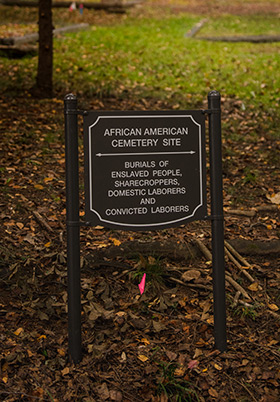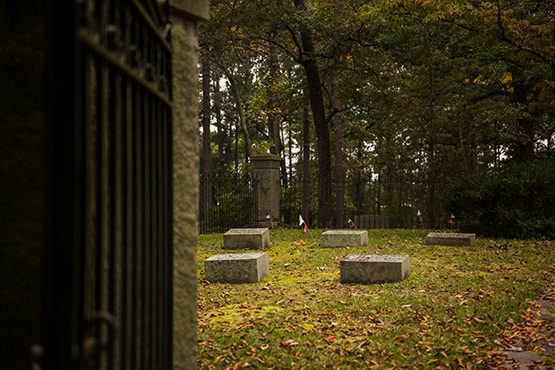Woodland Cemetery Updates
Our GPR Findings
Posted: October 23, 2020 | Category: GPR
After the initial findings were announced in August, the site team conducted several phases of additional ground-penetrating radar (GPR) work that ultimately resulted in a complete survey of the cemetery. That work revealed 604 unmarked burials—most of them clustered on the northern, northwestern, and western slopes of the hill, the area long understood as the African-American burial ground. A substantial number were also detected on the southern and southeastern quadrants of the hill, the site the university used for reburial when it removed and relocated African-American gravesites upon acquiring a court’s permission to do so in 1960.
The GPR survey also detected unmarked graves in areas the team had not anticipated—most notably, it identified 12 burials at the crest of the hill, within the fenced area enclosing the gravesites of several members of the Calhoun family. The first of these Calhoun family burials, John C. Calhoun, the young son of Andrew Pickens Calhoun, occurred in 1837; he is the first known white person buried in the cemetery. This finding raises the possibility that African Americans were buried on the site prior to the Calhoun family’s acquisition of Fort Hill.

Our Process
Before announcing the results of the GPR survey, we sought an external expert opinion and consultation. Professor Lawrence Conyers of the University of Denver, a recognized authority on GPR analysis with extensive background in cemetery sites around the world, reviewed the team’s procedures and methods, finding them valid and scientifically sound. We await the site team’s full, final report, which we anticipate within 6-8 weeks. As part of this consultation and review process, Clemson faculty members Scott Brame and Brady Adams Flinchum, both of the Department of Environmental Engineering and Earth Sciences, were also consulted to provide their expertise. Their onsite analysis indicated that it was highly unlikely that the GPR findings, or characteristics, were the result of naturally occurring elements—but instead appeared to be anthropogenic, or manmade. Professor Flinchum also conducted some additional GPR work at the African American cemetery at Hopewell—a means of comparing known 19th-century African American burials to the unmarked burials indicated by GPR at Woodland. The GPR characteristics of the burials at Hopewell—the known graves—were consistent with the characteristics of those at Woodland.
Time-Lapse of GPR Work at Woodland Cemetery

FIRST STEPS and NEXT STEPS
With the support of the Board of Trustees and the Legacy Council, we have taken our first steps. In addition to completing the GPR work, we have installed signage in the cemetery as well as adopted and installed appropriate security measures to protect the grounds. We continue to work toward stabilizing the site to address erosion. Our next steps follow on those: we continue to seek the guidance of African American community leaders—our goal is not just transparency, but collaboration and partnership. Professor Rhondda Thomas has helped to form a Citizens Advisory Council, with members representing Clemson/Central, Anderson, Pendleton and Seneca. They will help guide us in the preservation and memorialization of the site. She is also working with the local community to identify family members who may have ancestors buried in the unmarked graves.
Similarly, our research will continue. We remain committed to a full, truthful account of the cemetery, a process that will take time, diligence, and collaboration—but we have hired a faculty member dedicated solely to this work, Dr. Sara Collini. And beginning early next year, we will transition toward a more interactive and dynamic web presence—a fuller website that will continue to allow us to share documents and other archival material via our Living Archive, but will also give us the capacity to develop our content and our communication and engagement with our campus and our community.
